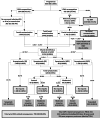Hygiene promotion might be better than serological screening to deal with Cytomegalovirus infection during pregnancy: a methodological appraisal and decision analysis
- PMID: 32546244
- PMCID: PMC7298945
- DOI: 10.1186/s12879-020-05139-8
Hygiene promotion might be better than serological screening to deal with Cytomegalovirus infection during pregnancy: a methodological appraisal and decision analysis
Abstract
Background: Cytomegalovirus infection is the most frequent viral congenital infection, with possible consequences such as deafness, or psychomotor retardation. In 2016, the French High Council of Public Health was mandated to update recommendations regarding prevention of cytomegalovirus infection in pregnant women. We summarize a critical appraisal of knowledge and deterministic decision analysis comparing the current no-screening situation to serological screening during pregnancy, and to hygiene promotion.
Methods: Screening was defined as systematic serological testing, during the first trimester, with repeated tests as needed, to all pregnant women. Outcomes were: 1) severe sequela: intellectual deficiency with IQ ≤ 50 or hearing impairment < 70 dB or sight impairment (≤ 3/10 at best eye); 2) moderate sequela: any level of intellectual, hearing or sight deficiency; and 3) death or termination of pregnancy. We simulated the one-year course of cytomegalovirus infection in a cohort of 800,000 pregnant women. We developed a deterministic decision model, using best and min-max estimates, extracted from systematic reviews or original studies.
Results: Relevant data were scarce or imprecise. We estimated that 4352 maternal primary infections would result in 1741 foetal infections, and an unknown number of maternal reinfections would result in 1699 foetal infections. There would be 788 cytomegalovirus-related consequences, including 316 foetal deaths or terminations of pregnancy, and 424 moderate and 48 severe sequelae. Screening would result in a 1.66-fold increase of poor outcomes, mostly related to a 2.93-fold increase in deaths and terminations of pregnancy, not compensated by the decrease in severe symptomatic newborns. The promotion of hygiene would result in a 0.75-fold decrease of poor outcomes, related to both a decrease in severe sequelae among symptomatic newborns (RR = 0.75; min-max: 1.00-0.68), and in deaths and terminations of pregnancy (RR = 0.75; min-max: 0.97-0.68).
Conclusions: Prevention of cytomegalovirus infection during pregnancy should promote hygiene; serological screening should not be recommended.
Keywords: Cytomegalovirus infection; Decision support techniques; Hygiene; Mass screening; Pregnancy.
Conflict of interest statement
The authors declare that they have no competing interests.
Figures


References
-
- Kenneson A, Cannon MJ. Review and meta-analysis of the epidemiology of congenital cytomegalovirus (CMV) infection. Rev Med Virol. 2007;17(4):253–276. - PubMed
-
- Dollard SC, Grosse SD, Ross DS. New estimates of the prevalence of neurological and sensory sequelae and mortality associated with congenital cytomegalovirus infection. Rev Med Virol. 2007;17(5):355–363. - PubMed
MeSH terms
LinkOut - more resources
Full Text Sources
Medical
Miscellaneous

